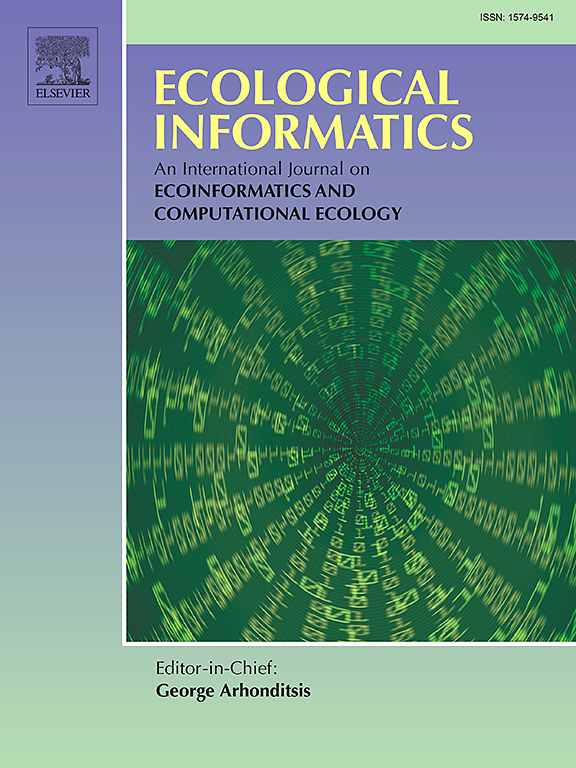通过时空尺度耦合分析提高物种动力学的准确性
IF 7.3
2区 环境科学与生态学
Q1 ECOLOGY
引用次数: 0
摘要
尺度效应会严重影响生态模型的合理性和准确性,因此在生态研究的构建和应用中都会包括时间和空间尺度。然而,很少有生态模式分析同时关注这两个尺度,这在同步性方面尤为重要。在本研究中,我们基于渔业捕捞数据和模拟数据,提出了时空尺度耦合分析框架,并揭示了传统尺度研究可能存在的不足。我们利用不同时空尺度组合的模拟数据验证了该方案的可行性和可靠性。结果表明,我们的方案可以同时识别和定位物种时空模式变化的尺度特征,特别是多个地点(或时间)的时间动态(或空间模式)的同步性和振幅。我们的方案揭示了空间尺度对 13 年尺度内在特征的重要影响,这极大地提高了我们对全球栉水母类渔业动态的理解。这表明,基于时空尺度耦合分析所得到的时空格局和尺度特征是完整的、更准确的。同时,我们的方案还能正确识别复杂的模式结构,如数据分层、时间和空间尺度的多重组合等,可减少实际应用中可能出现的误差。该方案可应用于未来生物多样性时空模式的识别和预测,有助于制定有效的政策,促进渔业资源的可持续管理和濒危海洋物种的全面保护。本文章由计算机程序翻译,如有差异,请以英文原文为准。
Coupled space-time scale analysis for obtaining enhanced accuracy in species dynamics
Scale effects significantly affect the rationality and accuracy of ecological models, so temporal and spatial scales are included in the construction and application of ecological studies. However, few ecological pattern analyses focus on both of these scales simultaneously, which is especially important in terms of synchrony. In this study, based on fishery catch data and simulated data, we propose a framework for coupled space-time scale analysis and reveal possible deficiencies in conventional scale studies. We verified the feasibility and reliability of the scheme using simulated data with different combinations of temporal and spatial scales. The results showed that our scheme can simultaneously identify and localize scale features in the variation in species spatial-temporal patterns, specifically regarding the synchrony and amplitude of temporal dynamics (or spatial patterns) of multiple sites (or times). Our scheme revealed that spatial scales had an important effect on the intrinsic 13-year scale features, which significantly improved our understanding of global Rajiformes fishery dynamics. This showed that the spatial-temporal patterns and scale features obtained based on the coupled space-time scale analysis were complete and more accurate. At the same time, our scheme correctly identified complex pattern structures, such as data stratification and multiple combinations of time and space scales, which can reduce possible errors in practical applications. This scheme can be applied to the identification and prediction of the spatial-temporal patterns in biodiversity in the future and will help in formulating effective policies promoting sustainable fishery resources management and comprehensive conservation of endangered marine species.
求助全文
通过发布文献求助,成功后即可免费获取论文全文。
去求助
来源期刊

Ecological Informatics
环境科学-生态学
CiteScore
8.30
自引率
11.80%
发文量
346
审稿时长
46 days
期刊介绍:
The journal Ecological Informatics is devoted to the publication of high quality, peer-reviewed articles on all aspects of computational ecology, data science and biogeography. The scope of the journal takes into account the data-intensive nature of ecology, the growing capacity of information technology to access, harness and leverage complex data as well as the critical need for informing sustainable management in view of global environmental and climate change.
The nature of the journal is interdisciplinary at the crossover between ecology and informatics. It focuses on novel concepts and techniques for image- and genome-based monitoring and interpretation, sensor- and multimedia-based data acquisition, internet-based data archiving and sharing, data assimilation, modelling and prediction of ecological data.
 求助内容:
求助内容: 应助结果提醒方式:
应助结果提醒方式:


